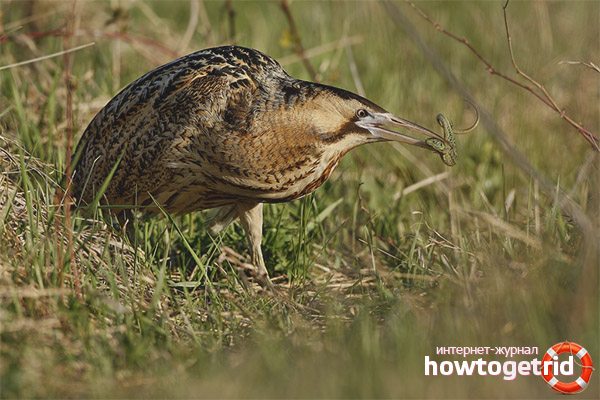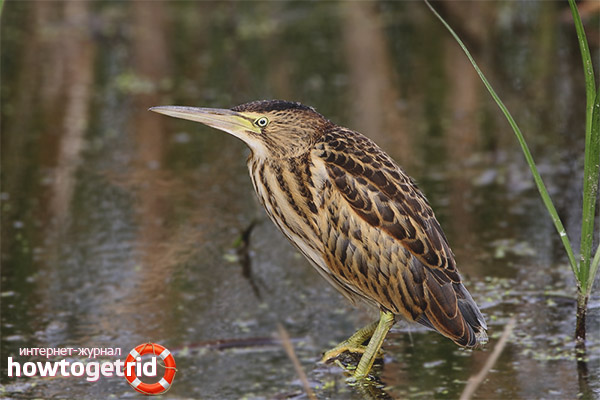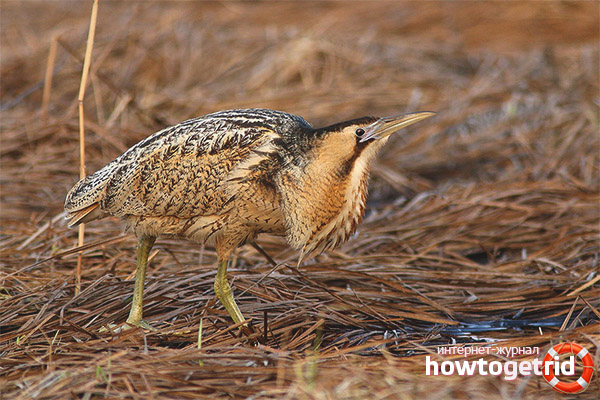The content of the article
A large bittern is a bird of the order Ciconiiformes, a heron family. This type of bird got its original name due to its loud voice, which in sound resembles loud cries and howls.
View description
This species of wading birds differs from other species in its rather large size and peculiar body shape. Another peculiarity of the bittern is its unique coloring of plumage, which has significant differences from many related species, which makes it recognizable.
Appearance
The color of the plumage of the tail of the bird is a yellowish-brown hue with a pronounced pattern of dark color. Note that this color of this swamp bird is, in fact, a camouflage outfit, which allows this bird, which is quite large in size, to remain almost invisible in the swampy area, overgrown vegetation.
The male is larger than the female. The weight of the individual reaches 2 kilograms with a bird height of 65-70 cm. The beak of the bittern is light yellow with many inclusions of dark color, eyes are yellow.
The color of the legs of the bird is dark gray, with a pale green tint, which is a characteristic difference of this species. Young individuals of bittern differ from adults in lighter and softer plumage colors. In the air during the flight, they are often confused with such a night predator like an owl.
Habitat, lifestyle and behavior
Although a bittern is a bird, mainly choosing swamps for its place of residence, it nevertheless refers to migratory species. As a rule, a bird returns to its nesting site after wintering in early spring. The natural habitat for it is large natural reservoirs with a small course and with abundant vegetation (reed, reeds).
Mass departure to the place of wintering begins with the arrival of cold weather (end of September - beginning of October). Sheds this species of birds once a year, from late summer to early January.
It is most active in the evening and at night. By hunting its prey, it is able to stand motionless for a rather long period of time. During the day, the bittern hides in the bushes and thickets, resting, she does this, like many of her relatives of the heron family, standing on one leg. When meeting with his enemy, the marshy bittern opens its beak wide, while burping all the food eaten before it.
The cry of bitterness is most often heard with the onset of the warm season, in spring and summer, the bird mainly emits characteristic cries at night or in the early morning. Especially often heard the cries of this bird with the beginning of the mating season. Sounds are made through the esophagus, which, due to bloating, acts as a very resonator, which is why the "cries" of the bird are amplified many times and can be heard several kilometers from the place where it nests.
Interesting fact! When a danger arises, the marsh bittern quickly regroups, stretching its neck, and then abruptly freezes, which is a very effective disguise, as it makes the bird very similar to ordinary reed.
The life expectancy of this species of marsh birds in the optimal habitat is about 13-15 years.
This kind of wading birds can be found on the territory of European countries, in the Mediterranean. Some populations chose southern Sweden, Denmark, Finland as their place of residence. Wintering places: Africa, India, China.
Natural enemies
The destruction of natural conditions for their nesting, that is, its natural habitat, causes the greatest harm to the population of this marsh bird. This is due to drainage work in large areas, which, in fact, is the reason for the reduction in the number of species.
Also, no less harm for this type of bird is caused by vegetation that often arises from the abnormal heat. Often, this causes the death of most plants suitable for both bird consumption and nesting.
The natural enemies of the swamp bittern include birds of prey that destroy young animals.
Power Features

The basic ration of a large bittern is mainly river fish. Also, tritons, frogs, insects, rodents often become prey. In the event that the bird does not have enough food, it can get it by ruining the bird's nests.
Reproduction of the species
The nest of the marsh bird has a peculiar shape (round, with sides) and, as a rule, is built in thickets of dense vegetation of the reservoir. As the chicks grow, the family nest begins to sink into soft, moist soil or into water, which is why a pair of birds constantly builds it.
Eggs are grayish-clay in color and quite regular in shape. Basically, egg laying is done by the female, but if necessary, the male can replace the latter. The number of eggs of one clutch reaches 8 pieces. Each hatches with an interval of several days; for this reason, the chicks hatch asynchronously. As a rule, the youngest chick in the clutch dies. Feeding the chicks by their parents continues for one and a half to two months after their appearance. The ability to fly in bittern chicks appears from the age of two months.
Video: Bittern (Botaurus stellaris)











Submit